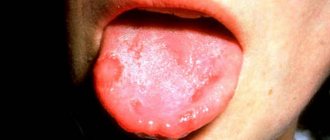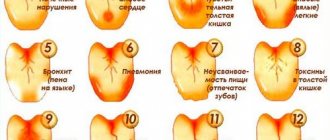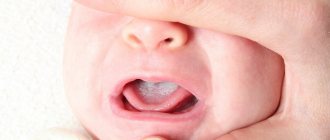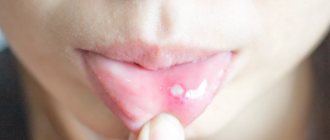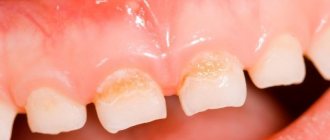One of the most common childhood diseases is stomatitis: according to statistics, more than 80% of parents experience it.
This is not as harmless a disease as it may seem, because if the disease is ignored and left untreated, the infection can lead to complications that will require much more time and effort to combat. Therefore, it is extremely important to know what childhood stomatitis looks like, as well as how to treat it.
Causes of stomatitis in a child
In childhood stomatitis, the mucous membrane of the oral cavity is affected: small pimples of white or yellowish color, filled with liquid, appear on its surface. In some cases, ulcers form.
Stomatitis is predominantly a childhood disease, although it can also occur in adults. The rash affects the inner surface of the cheeks, tongue and gums. The disease causes a lot of inconvenience: pimples hurt and itch, their appearance is accompanied by a burning sensation in the mouth.
Among the main reasons for the development of stomatitis are:
- poor oral hygiene;
- injury to the mucous membrane;
- diseases of the gastrointestinal tract;
- oral burn;
- pathogenic bacteria that enter the oral cavity from dirty hands, toys, etc.
Reasons for appearance
There are many reasons why a child may develop such formations. Let's look at each of them in more detail.
Traumatic damage to the tongue
After 3 months, children begin to actively explore everything that surrounds them and taste everything. But objects that enter the baby’s mouth are not always sterile. Older children often chew on sharp objects that can easily cut or scratch their tongue. Even with minor trauma to the mucous membranes, microbes can enter them, and as a result, an inflammatory process develops and painful pimples appear, most often localized on the tip of the tongue.
Oral candidiasis or thrush
Babies under 1 year of age do not have a sufficiently developed immune system, so after any illness the body’s protective properties are reduced. As a result, active growth of Candida fungi occurs on the mucous membranes and oral candidiasis occurs.
Taking antibiotics also contributes to this. One of the typical symptoms of thrush is the appearance of pimples and a white cheesy coating on the entire surface of the tongue; they may also spread throughout the entire oral cavity. After removing such plaque, you can see swelling, redness and even small ulcers underneath.
Stomatitis
Stomatitis is manifested by the presence on the tongue (its root, tip, side surfaces) of small, painful white pimples that cause discomfort when speaking and while eating. If these pimples coalesce, large ulcers can form. In severe cases of the disease, the baby’s body temperature rises and general well-being is disturbed.
Allergic reactions
Children under two years of age are much more likely than adults to experience allergies. One of its manifestations is the appearance of small red or white pimples on the tongue. They can be found both at the root and at the tip of the tongue. Such pimples tend to spread to the palate, gums, lips and other parts of the oral mucosa. Such formations most often cause anxiety to the baby, cause pain when eating, swallowing, and itching. But body temperature remains within normal limits.
Allergy symptoms intensify and new pimples appear due to the use of a product to which you are hypersensitive. Often, such allergic reactions can be caused by the use of toothpaste or other oral care products, even if they are recommended for use by children.
Angina
A bacterial infection that affects the tonsils in childhood can also spread to the lymphoid tissue located closer to the throat, at the root of the tongue. In this case, white pimples with a purulent coating appear in the tongue area. If the pus is removed, you may see exposed areas with minor swelling and redness. Such formations are painful, they interfere with normal swallowing and worsen the overall well-being of the baby: he refuses to eat, is capricious, and the body temperature may be elevated. In the presence of such pimples, it is often possible to detect enlarged lymph nodes near the throat.
Herpetic infection
In childhood, it is very easy to become infected with the herpes virus. The infection worsens as a result of a decrease in the body's immune defense. Small watery pimples on a red background appear on the tongue. They can also be found on a child's lips or throat. They are characterized by severe pain, and after they burst, such pimples leave shallow ulcers that prevent the baby from speaking and eating normally.
Unbalanced diet and intestinal dysbiosis
If there are errors in the nutrition of children, especially young children, if the composition of the normal intestinal microflora is disrupted, glossitis can develop - inflammation of the mucous membrane of the tongue. As a result of this, active division of the epithelium of the papillae occurs and they look like inflamed whitish6 or red pimples. They rarely cause concern to the child; sometimes sensitivity to cold, sour or hot food changes slightly.
Symptoms of the disease
Before treatment can begin, the disease must be recognized. Stomatitis has a number of symptoms, thanks to which the disease cannot be confused with any other. These include:
- the appearance of swelling of the mucous membrane;
- formation of yellow or white plaque on the mucous membrane;
- enlarged lymph nodes, accompanied by an increase in body temperature;
- constant formation of saliva in large quantities (sometimes, on the contrary, stomatitis is accompanied by increased dryness);
- bad breath.
The photo gives a clear understanding of what stomatitis looks like.
These are general symptoms, but they may have their own characteristics depending on the type of disease:
- allergic stomatitis is accompanied by the formation of ulcers on the palate, tongue, inner cheeks, and gums;
- aphthous stomatitis is characterized by the formation of larger yellow spots, up to 1 cm in diameter, with inflamed edges;
- Herpetic stomatitis can be distinguished by the abundance of small fluid-filled rashes that combine into one large wound. In addition, herpes can cause a general deterioration in health - high fever, weakness and body aches;
- with candidal stomatitis, a white coating appears on the inner surface of the cheeks and tongue. The cause of candidiasis is poor hygiene or a consequence of antibacterial therapy.
Regardless of what kind of stomatitis the child has, treatment should be prescribed immediately after the first signs of the disease are detected: delay is fraught with aggravation of the situation, which will lead to an increase in healing time. How to treat stomatitis in children in the mouth will depend on the form of the disease and the reasons for its development: treatment methods in each case will be unique.
Pimples on the tongue - what are they?
The mucous membrane in the mouth and tongue does not have sebaceous glands, so typical pimples cannot form on it. Such formations have two formation mechanisms:
- Under the influence of damaging factors, viruses or bacteria, the mucous membrane stratifies, under the top layer of which liquid accumulates and small bubbles form. If such a formation is not infected, then its contents will be transparent, but if infection has penetrated into its cavity, then suppuration is possible - the vesicle will turn white. If blood gets into the liquid, then this formation takes on a red or dark tint. The blisters may burst and painful ulcers form in their place.
- Sometimes, in response to inflammation, cells on the surface of the tongue begin to actively divide and slough off. Whitish or red formations form that resemble ordinary pimples, but at the same time they are only enlarged papillae.
How to treat childhood stomatitis
Once the diagnosis has been made, treatment for stomatitis should begin as soon as possible. It is necessary to keep in mind that prescribing medications yourself: the decision can only be made by a pediatrician who has information about how this or that medicine can further affect the well-being of a small patient. First of all, the doctor must prescribe a scraping to determine the type of causative agent of the disease, and a virological study: depending on this, the type of treatment is prescribed.
The duration of treatment is influenced by the advanced stage of the disease and the type of stomatitis: on average, it is possible to overcome the disease within a week, provided that the doctor’s recommendations are fully followed.
Children's stomatitis: treatment with medications
Doctors prescribe symptomatic medications, the purpose of which is to get rid of the symptoms that accompany the development of the disease.
Appointed:
- vitamin complexes to strengthen the child’s immunity as a whole;
- antiviral drugs;
- antipyretic drugs;
- gels and ointments for treating the oral cavity.
In addition, it is recommended to drink plenty of fluids and eat a diet that excludes the consumption of spicy, sour and highly salty foods.
The most commonly prescribed drugs for stomatitis are:
- Miramistin. An antifungal solution that prevents wound infection. The drug starts the process of regeneration of damaged tissues.
- Vinilin is an anesthetic with a healing effect. The medicine forms a protective film on the surface of the ulcers, protecting them from irritation when eating food, as a result of which the healing process is accelerated.
- Nystatin is an effective treatment for candidal stomatitis.
- Metrogyl Denta is an antibacterial drug applied twice a day to damaged areas of the mucous membrane.
- Acyclovir is an antiviral drug that prevents new lesions of the rash from appearing. The drug is applied up to 6 times during the day. Thanks to its use, the formation of crusts is accelerated.
Children's stomatitis: treatment with folk remedies
Many parents, in addition to or even instead of medications, prefer to use traditional medicine. As mentioned above, you should not do this without the consent of your doctor, however, you cannot fail to mention these methods of treatment.
So, among these funds it is worth highlighting:
- soda-salt solution. An equal amount of soda and salt are dissolved in a glass of water (about half a teaspoon of each component). It is recommended to rinse your mouth with the resulting solution 4 times a day after meals;
- infusion of chamomile with honey. For the solution, take a glass of boiling water and a tablespoon of chamomile. When the liquid cools, add 2 teaspoons of honey. The product is used for rinsing 3 times a day;
- brilliant green is the most affordable remedy available for sale in any pharmacy. It dries out wounds and prevents new foci of disease from forming.
Treatment
When treating, regardless of the causes that cause them, there are the following general points:
- It is imperative to maintain careful oral hygiene. After each meal, it is advisable to treat pimples with an antiseptic solution.
- Eliminate any irritating factors such as sour, hot or spicy foods from your baby’s daily diet. It is advisable to eat soft foods during illness, so you can avoid additional injury to the mucous membrane.
- It is strictly forbidden to open or squeeze out pimples; as a result, the child’s condition may worsen and there is a high risk of complications.
- In such cases, it is advisable to drink as much fluid as possible, which will help ensure that toxins and allergens are easily eliminated from the baby’s body.
If pimples cause pain and discomfort in the child, then the doctor may advise the use of local remedies with anti-inflammatory and analgesic effects (Metrogil denta, Solcoseryl).
If the occurrence of pimples is caused by stomatitis or tonsillitis, the doctor may prescribe antibacterial drugs in combination with antiseptics.
Allergy treatment involves mandatory elimination of exposure to the allergen and the use of antiallergic drugs. In the case of herpetic lesions of the mucous membranes, one can expect the effect of antiviral drugs, and in case of candidiasis - drugs with antifungal action.
Before starting treatment, it is imperative to find out the reasons for their appearance. After all, all further treatment tactics depend on them. To make a correct diagnosis, you definitely need to visit the dentist. Do not forget that self-treatment can only harm the baby.
Add a review (comment)
By submitting this form you accept the privacy policy.
Reviews
+1 Ella 06/12/2015 21:12 And I noticed that the child, and myself, also have a reaction in the form of small pimples after eating sour fruits, especially citrus fruits.
I wonder what it could be? I myself think that this is mechanical damage to the mucous membrane by acids, the pimples go away after two or three days, but there is still a slight pain in the mouth. We don’t really treat it, we just try to adjust the diet. Reply | Reply with quote | Quote | Report to moderator
-1 Anna 03/06/2015 00:27 I think so, pimples are more often either mechanical damage or candidiasis, especially if plaque is also visible. In the case of candidiasis, it is better to see a doctor, now there are only drugs, it is difficult to choose the right one yourself. And at home it would be good to rinse your mouth with antiseptic and herbs such as chamomile, a good and harmless aid in complex treatment. And of course, do not give hot and spicy food.
Reply | Reply with quote | Quote | Report to moderator
Update list of comments
Herpetic stomatitis in children
There are several types:
- sharp;
- chronic.
This type of damage to the oral mucosa occurs when the herpes virus first enters the human body. Acute stomatitis is typical only for young children. Herpetic stomatitis that occurs repeatedly is called chronic. Herpes stomatitis in an infant appears due to infection of the child by the mother or other people who kiss the baby out of excess of feelings or taste food with the spoon with which he is then fed.
Acute herpes-type stomatitis
The herpes virus enters the baby's body after he reaches the age of six months. At this time, the antibodies the child received from the mother gradually cease to act. In the vast majority of cases (about 90%), the symptoms of stomatitis at such an early age are mild, and only in 10% of children the disease is acute.
Stomatitis in children under one year of age, the treatment of which takes about 2 weeks, is accompanied by weakness in the body, general malaise and muscle pain, which is explained by poisoning of the body. In some cases, the temperature during the first two days of the disease may rise to 40 degrees or higher. The lymph nodes become inflamed, and touching them causes pain to the baby.
A distinctive sign of the disease are small bubbles that appear in groups on the lips, palate, and tongue. The oral mucosa takes on a bright red hue. The bubbles are filled with a clear liquid that gradually becomes cloudy. After about 3 days, the blisters burst, leaving behind erosions covered with a yellow or white fibrinous coating.
Sometimes the gums near the teeth may turn red, so the disease is often confused with gingivitis.
Chronic stomatitis
Once the herpes virus enters the human body, it remains there forever. Symptoms may occur when:
- cold;
- lack of vitamins;
- stressful situations;
- exacerbation of sinusitis, tonsillitis and other chronic diseases;
- injury to the mucous membrane;
- gingivitis or caries;
- habit of breathing through the mouth (lips become dry, causing the skin in the corners of the mouth to crack).
Chronic stomatitis develops in exactly the same way as acute stomatitis, with the exception that the disease does not affect the general condition of the body, because intoxication is minimal.
Herpetic stomatitis in children: how to treat
Types of treatment:
- Use of antiviral agents. Ointments and gels, which are often used to treat herpes on the lip, should not be applied to the oral mucosa. Treatment is possible with suppositories or tablets. The most effective drugs include two drugs. The first of them is “Viferon”, which contains interferons that have an immunostimulating effect. Available in the form of suppositories and gel. There are no age restrictions on the use of the product. The gel should be applied directly to the affected mucous membrane, after drying it with a swab. The treatment period does not exceed one week, provided that the product is regularly applied three times a day. The second is the antiviral drug Acyclovir, which acts on the herpes virus itself, and does not simply increase immunity. The dosage regimen is the same for children over 2 years of age and twice.
- Rinse. It is necessary to use solutions whose action is aimed specifically at suppressing the herpes virus (such popular and cheap remedies as chlorhexidine and various herbal infusions are not suitable). The most effective drug is Miramistin, which should be rinsed three times a day. For greater results, you can apply Viferon a short period of time after rinsing.
- Use of symptomatic remedies. Antipyretic drugs are used when body temperature exceeds 38 degrees. At lower temperatures, such tablets will do more harm, since they will interfere with the formation of natural immunity and the production of interferons.
- Use of immunomodulators. If stomatitis in children, which was treated according to all the rules, makes itself felt again, you can resort to the use of immunomodulators, the most effective of which are:
- “Immunal” is a basic drug that increases immunity.
- “Imudon” stimulates the immunity of the oral mucosa. One course lasts 20 days (you need to take 6 tablets every day). 2 courses per year are recommended.
- Toothpastes with lactoferrin and lysozyme (these substances are contained in special Splat children's toothpastes).
Aphthous stomatitis in children
Manifests itself in the form of small individual ulcers on the lips and oral mucosa. Its appearance is provoked by:
- allergic reactions of various types (to food, medications, etc.);
- staphylococci (there are many of these bacteria in carious formations and dental plaque);
- immunity disorders;
- liver diseases.
Aphthous stomatitis in children: symptoms and treatment
Exacerbation occurs mainly in autumn and spring. Ulcerations most often form on the lips, tongue and inside the cheeks (in these places the mucous membrane comes into contact with food and can be injured by the teeth).
Sometimes weakness in the body and fever appear, but often the general condition of the body remains normal.
The size of the ulcers (ulcers) is 5-10 mm. They are covered with a grayish coating and are surrounded by a red, inflamed rim of mucous membrane. There is pain when touching them. It happens that only 1 ulcer forms.
Aphthous stomatitis in children: treatment
The causes of stomatitis in children will influence the nature of treatment. Immediately after the first symptoms appear, it is necessary to adjust the child’s menu, completely eliminating the main allergens (chocolate, honey, berries, citrus fruits, etc.). During illness, you should also not eat spicy foods with added spices.
Often, aphthous stomatitis becomes a reaction of the body to medications, so if a child is taking medications, it would be a good idea to consult a doctor.
Treatment methods:
- Antiallergic drugs. The most frequently prescribed are Suprastin, Diazolin and many others like them.
- Treatment of ulcerations. At the initial stage of the disease, “Miramistin” (they are recommended to spray the aphras using a special sprayer that comes with the drug) and “Cholisal” (ulcers are treated with gel at least 3 times a day) perform well. When the acute symptoms of the disease pass, you can use Solcoseryl, a gel that accelerates the healing of mucosal defects and has an analgesic effect.
- Exposure to UV rays in a physiotherapy room.
- Use of immunomodulators. Firstly, it is worth purchasing a special toothpaste based on lactoferrin, and secondly, you can take a course of Imudon.
- Sanitation of the oral cavity. Since one of the causes of stomatitis is microorganisms, all carious formations must be cured and plaque removed.
Preventive measures to prevent stomatitis in children
To minimize the risk of developing stomatitis you need to:
- wash the child’s toys, bottles and other things regularly, and do not forget to thoroughly wash the baby’s hands;
- strengthen the child’s immunity;
- do not let your child bite his nails;
- create a balanced menu containing all the necessary minerals and vitamins. The diet should be followed;
- promptly treat diseases such as tonsillitis, gastritis and other gastrointestinal diseases. If you extinguish the outbreak in time, this will prevent stomatitis from developing;
- At least once a year, and preferably twice, visit the dentist for a detailed examination of the oral cavity.
All these simple recommendations will help avoid the occurrence of stomatitis, because any disease is much easier and cheaper to prevent than to treat it later. If it was not possible to avoid the disease, at the first signs of it, you must consult a doctor to prescribe effective treatment. If stomatitis appears again and again, a thorough immunological examination is required. The child should be examined by a pediatrician and an immunologist; it is also advisable to contact an endocrinologist and gastroenterologist (perhaps they will identify a chronic disease leading to relapse of the disease).
It is equally important to teach your child proper oral hygiene. If the teeth are affected by caries and covered with plaque, and there are fistulas on the gums, the fight against stomatitis will not be successful. A child must be taught how to properly brush his teeth and gums by buying him a brush and toothpaste appropriate for his age.

